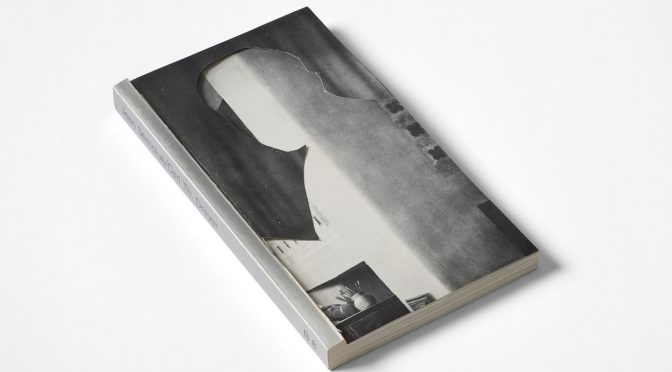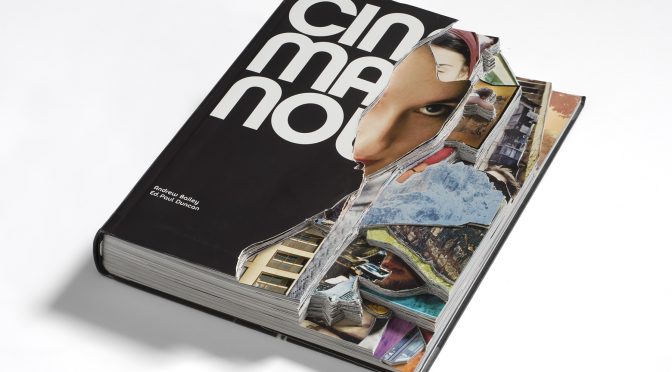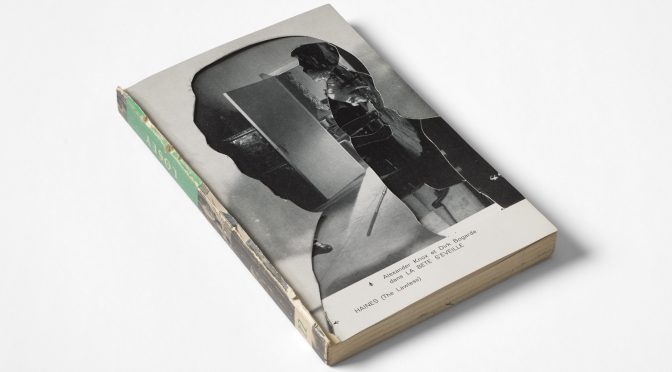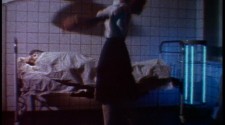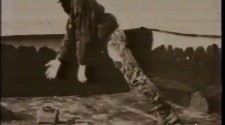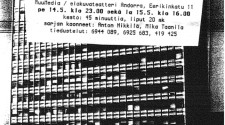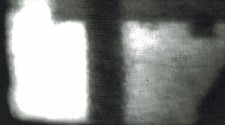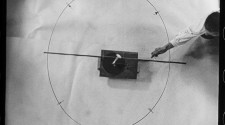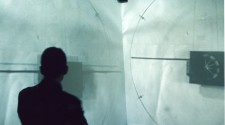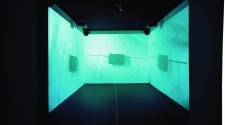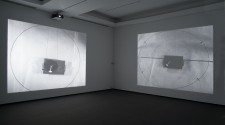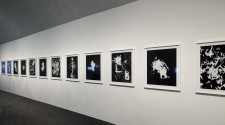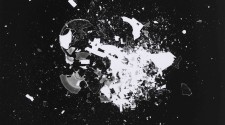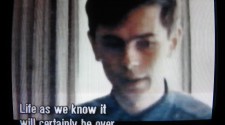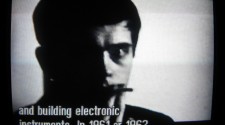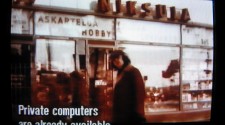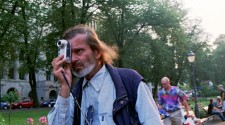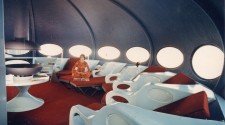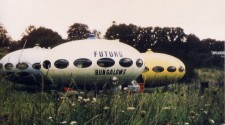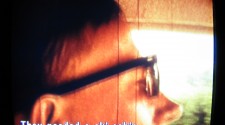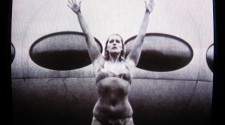All posts by Kimmo Lehtonen
Cinmano ( )
January 1, 1970The Beast ( )
January 1, 1970The Beast from the series Film Reader (74 x 114 x 13 mm) photo: Johnny Korkman © Mika Taanila 2017
Tongue ( )
January 1, 1970THE DOUBLE (1993)
January 1, 1970The Double – Russian industrial music and low tech videos is a music video compilation made in 1993 by Anton Nikkilä and Mika Taanila. It draws together 11 film and video works made in the era of the first wave of Russian underground music videos – the late 1980’s and early 1990’s. It also features a documentary introduction shot in Moscow by the compilers in 1993.
SELECTED SCREENINGS
- MuuMedia Festival, Helsinki 1993
- Videopolis, YLE TV1, 1993
- Rearview Mirror Towards Reality Festival, Linz, 1996
- Back In Ex-USSR Festival, Brussels, 2001
- MY Sound of Music Festival, Salzburg, 2014
A Physical Ring (2001)
January 1, 1970This ready-made film is based on anonymous footage of a physics experiment filmed in Finland in the 1940s. I discovered an abandoned film can at the Finnish Film Archive labelled with a dirty sticker saying ‘physical ring’. My attempts to find out more about the experiment led nowhere. All we see are kinetic ‘magic’ elements: what appears to be fire, magnets, heat, metal and motion. The installation consists of swaying, unending, unsynchronized footage that can be projected on one, two or three walls simultaneously, or even on the floor. The film version has a clear beginning, middle and end. (MT / translation: Silja Kudel)
Music: Ø (Mika Vainio)
Special effects for the short film version: Jussi Eerola
Distributed by AV-arkki, Helsinki (digital) and Light Cone, Paris (35 mm)
Kari Yli-Annala: The Enigma of A Physical Ring (2002)
Kari Yli-Annala: Fysikaalisen renkaan arvoitus (2002)
Selected screenings
[• => installation]
- Rock, Paper, Scissors, Kiasma, Helsinki, 2025 •
- Zwei Tage Strom, Walcheturm, Zürich, Switzerland, 2024 •
- Gegenkino, Leipzig, Germany, 2017
- Stuttgarter Filmwinter, Germany, 2016
- MuHKA_media, Antwerp, Belgium, 2006
- Human Engineering, Migros Museum für Gegenwartskunst, Zürich, Switzerland, 2005 •
- Hotel Futuro, Spacex Gallery, Exeter, UK, 2005 •
- 4-D, Curves and Straight Lines, Film Museum Amsterdam, The Netherlands, 2004
- Media City 9, Artcite Inc. Gallery, Ontario, Canada, 2003
- IFFR Rotterdam, The Netherlands, 2003
- Starting From Scratch, De Balie, Amsterdam, 2003
- Glasgow CCA, Scotland, 2003
- The Other Cinema, London, 2003
- Electric Visions/Look At Yourself, Sala Rekalde, Bilbao, 2003 •
- Radar, Tyco Brahe Planetarium, Copenhagen, 2002 •
- Ars Electronica / Cyberarts 2002, O.K. Centrum für Gegenwartskunst, Linz, Austria, 2002 •
- Viva Helsinki, Sonar, Barcelona, 2002 •
- Manifesta 4 – European Biennial of Contemporary Art, Frankfurt/Main, Germany, 2002 •
- Fysikaalinen rengas / A Physical Ring, Kontti, Kiasma Museum of Contemporary Art, Helsinki, 2002 •
Black and White Movies (2013)
January 1, 1970These photograms are remnants of old VHS movies that had accumulated on my bookshelf over the years: TV recordings, fourth-generation copies taped by friends, mail-order rarities. All are inspired by violent sequences that had lingered in my mind. If the original film showed someone torturing a prisoner by scorching his chest with a blowtorch, I proceeded to do the same to the VHS cassette. If the hero smashed his head against a rock, I too would smash the tape with a rock. Next I gathered up the smashed pieces, scattered the plastic and metal debris across photo paper, and exposed it in a darkroom without a camera. Each photogram is named after the original film. (MT / translation: Silja Kudel)
- Strait-Jacket
- Sommerlek (Summer Interlude)
- Kiss Me Deadly
- Le feu follet (The Fire Within)
- Häxan (Witchcraft through the Ages)
- White Heat
- Kahdeksan surmanluotia (Eight Deadly Shots)
- Les yeux sans visage (Eyes Without a Face)
- The Incredible Shrinking Man
- Kid Speed a.k.a. The Four-Wheeled Terror
- Faster Pussycat Kill! Kill!
- La Haine (Hate)
- Le Peau douce (The Soft Skin)
- Honeymoon Killers
- Roma, città aperta (Rome, Open City)
- Out of the Past
All works are based on black & white movies from 1924-1995 recorded on VHS home video cassettes, then destroyed and reworked as photograms.
Photo book “Black and White Movies” published by Luova in 2018.
Selected shows:
- Damage/Control, Padiglione de l’Esprit Nouveau, Bologna, 2020
- Partial Head Clog, La Neomudéjar, Madrid, Spain, 2018
- Cleaning Tapes, Konsthallen, Sandviken, Sweden, 2017
- Memoria esterna, Artopia Rita Urso, Milan, Italy, 2017
- Action Films, balzer projects, Switzerland, 2016
- Blackout, Hämeenlinna Art Museum, Finland 2015–2016
- Post Script, de Gouvernestraat, Rotterdam, The Netherlands, 2014
- Aikakoneita – Time Machines, Kiasma Museum of Contemporary Art, Helsinki, Finland, 2013
- Tomorrow’s New Dawn, Contemporary Art Museum, St. Louis, USA, 2013
The Future Is Not What It Used To Be (2002)
January 1, 1970Is the merging of man and machine really possible? Or has it already happened? This is a film about 1960s avant-garde music and film, the early history of microcomputers and the open questions of 21st century science. It is also a portrait of the nuclear physicist/artist Erkki Kurenniemi (b. 1941), one of the unsung pioneers of early electronic art. Kurenniemi has been exploring the potential of virtual reality and interactive computer art in diverse projects since the early 1960s. The film is structured around Kurenniemi’s “manic collection project”, in which he constantly and feverishly recorded his thoughts, everyday observations, objects and images, with the ultimate aim of merging man and machine – thereby reconstructing the human soul. (MT / translation: Silja Kudel)
“Erkki Kurenniemi’s journey from future-minded visionary working at the interface of science and art, a fresh-faced young man who pioneered computers and robotics and kept one bright eye always on the stars above, to the haggard and slightly potty sixty-something frantically collating the remains of his last days for the benefit of some future race of curators strikes me as perfect parable of our times.” – Simon Reynolds: Retromania – Pop Culture’s Addiction to Its Own Past, (Faber&Faber 2011, London).
Cinematography: Jussi Eerola, Sound Design: Olli Huhtanen, Music: Erkki Kurenniemi, Jukka Ruohomäki, Sähkökvartetti, György Ligeti, Production: Kinotar / Ulla Simonen, Lasse Saarinen
Selected screenings
- Zwei Tage Strom, Filmpodium Zürich, Switzerland, 2024
- Damage/Control, Padiglione dell’Esprit Nouveau, Bologna, Italy, 2020
- Close-Up Cinema, London, UK, 2017
- Goethe Institut London, UK, 2016
- Moderna Museet, Stockholm, Sweden, 2014
- La Casa Encendida, Madrid, Spain, 2014
- IFFR Rotterdam, The Netherlands, 2013
- On The Spot #4, Badischer Kunstverein, Karlsruhe, Germany, 2008
- Arctic Hysteria, P.S.1 Contemporary Art Center, New York, 2008
- Massachusetts Museum of Contemporary Art, USA, 2008
- Lost & Found, S.M.A.K. Stedelijk Museum voor Actuele Kunst, Gent, Belgium, 2007
- Lustforlife, The Breeder Gallery, Athens, 2006
- Human Engineering, Migros Museum für Gegenwartskunst, Zürich, Switzerland, 2005
- Hotel Futuro, Spacex Gallery, Exeter, UK, 2005
- Electrohype, Malmö Konsthall, Sweden, 2005
- 3rd Berlin Biennial for Contemporary Art, KW Institute for Contemporary Art, Berlin, Germany 2004
- Heavy Snowflakes, Ex Teresa Space for Contemporary Art, Mexico City, 2004
- Heavy Snowflakes, Museo de Arte Moderno de Buenos Aires, Argentina 2004
- 49th Karlovy Vary International Film Festival. Czech Republic, 2003
- Transparente: interni e esterni, Centro Nazionale per le Arti Contemporanee, Rome, 2003
Futuro – A New Stance for Tomorrow (1998)
January 1, 1970Taking us on a journey back in time to our recent futuristic past, this film is about the rise and fall of the plastic Futuro House, a Space Age utopia that almost became a reality. The Futuro leisure home designed by architect Matti Suuronen was unveiled in 1968 and licensed to 24 different countries. It is both a product of its time and a utopian vision of ‘a new stance for tomorrow’. Its flying saucer-like elliptic shape reflects late-60s optimism about the forthcoming conquest of space. Mankind was believed to be entering a new era in which technology would solve all imaginable problems. “By the 1980s, entire blocks of flats will be constructed out of plastic.” (MT / translation: Silja Kudel)
Cinematography: Jussi Eerola, Sound Design: Olli Huhtanen, Co-script: Marko Home, Music: Ektroverde, Dick Hyman, 101 Strings, Set Design: Kari Juusonen, Production: Kinotar / Lasse Saarinen
Selected screenings
- Zwei Tage Strom, Filmpodium Zürich, Switzerland, 2024
- IFFR Rotterdam, 2013
- Architektonika, Hamburger Bahnhof, Berlin, 2012
- Arctic Hysteria, Rosphoto State Museum and Exhibition Centre, St. Petersburg, 2012
- Arctic Hysteria, Ludwig Museum, Budapest, 2009
- On The Spot #4, Badischer Kunstverein, Karlsruhe, Germany, 2008
- Arctic Hysteria, P.S.1 Contemporary Art Center, New York, 2008
- Lost & Found, S.M.A.K. Stedelijk Museum voor Actuele Kunst, Gent, 2007
- Shanghai Biennale, Shanghai Museum of Art, China, 2006
- Human Engineering, Migros Museum für Gegenwartskunst, Zürich, 2005
- Hotel Futuro, Spacex Gallery, Exeter, UK, 2005
- Transparente: interni e esterni, Centro Nazionale per le Arti Contemporanee, Rome, 2003
- GOKANN – The 109th Exhibition of Finnish Artists / The Fourth Triennale, Kyoto Art Center, Japan, 2003
- Les Années Pop, Centre Pompidou, Paris, 2001
- Vision & Reality, Louisiana, Copenhagen, 2000
- The Day of The Donkey Day, Transmission Gallery, Glasgow, Scotland, 1999

